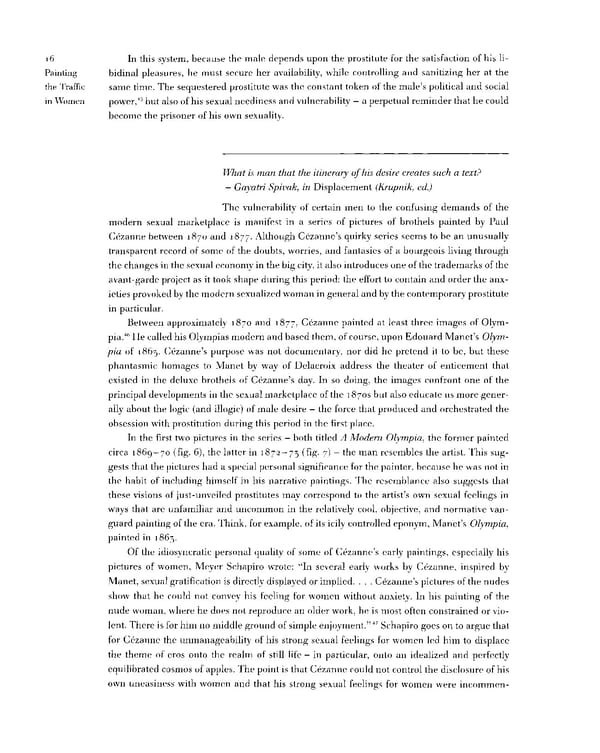16 In this system, because the male depends upon the prostitute for the satisfaction of his li- Painting bidinal pleasures, he must secure her availability, while controlling and sanitizing her at the the Traffic same time. The sequestered prostitute was the constant token of the male's political and social in Women 45 power, but also of his sexual neediness and vulnerability — a perpetual reminder that he could become the prisoner of his own sexuality. What is man that the itinerary of his desire creates such a text? - Gayatri Spivak, in Displacement (Krupnik, ed.) The vulnerability of certain men to the confusing demands of the modern sexual marketplace is manifest in a series of pictures of brothels painted by Paul Cezanne between 1870 and 1877. Although Cezanne's quirky series seems to be an unusually transparent record of some of the doubts, worries, and fantasies of a bourgeois living through the changes in the sexual economy in the big city, it also introduces one of the trademarks of the avant-garde project as it took shape during this period: the effort to contain and order the anx- ieties provoked by the modern sexualized woman in general and by the contemporary prostitute in particular. Between approximately 1870 and 1877, Cezanne painted at least three images of Olym- 46 pia. He called his Olympias modern and based them, of course, upon Edouard Manet's Olym- pia of 1863. Cezanne's purpose was not documentary, nor did he pretend it to be, but these phantasmic homages to Manet by way of Delacroix address the theater of enticement that existed in the deluxe brothels of Cezanne's day. In so doing, the images confront one of the principal developments in the sexual marketplace of the 18708 but also educate us more gener- ally about the logic (and illogic) of male desire — the force that produced and orchestrated the obsession with prostitution during this period in the first place. In the first two pictures in the series — both titled A Modern Olympia, the former painted circa 1869 — 70 (fig. 6), the latter in 1872 — 73 (fig. 7) — the man resembles the artist. This sug- gests that the pictures had a special personal significance for the painter, because he was not in the habit of including himself in his narrative paintings. The resemblance also suggests that these visions of just-unveiled prostitutes may correspond to the artist's own sexual feelings in ways that are unfamiliar and uncommon in the relatively cool, objective, and normative van- guard painting of the era. Think, for example, of its icily controlled eponym, Manet's Olympia, painted in 1863. Of the idiosyncratic personal quality of some of Cezanne's early paintings, especially his pictures of women, Meyer Schapiro wrote: "In several early works by Cezanne, inspired by Manet, sexual gratification is directly displayed or implied. . . . Cezanne's pictures of the nudes show that he could not convey his feeling for women without anxiety. In his painting of the nude woman, where he does not reproduce an older work, he is most often constrained or vio- 47 lent. There is for him no middle ground of simple enjoyment." Schapiro goes on to argue that for Cezanne the unmanageability of his strong sexual feelings for women led him to displace the theme of eros onto the realm of still life — in particular, onto an idealized and perfectly equilibrated cosmos of apples. The point is that Cezanne could not control the disclosure of his own uneasiness with women and that his strong sexual feelings for women were incommen-
 Prostitution & Impressionists Page 36 Page 38
Prostitution & Impressionists Page 36 Page 38